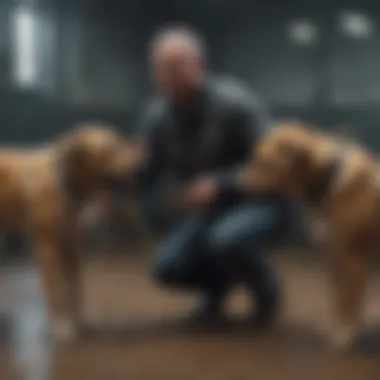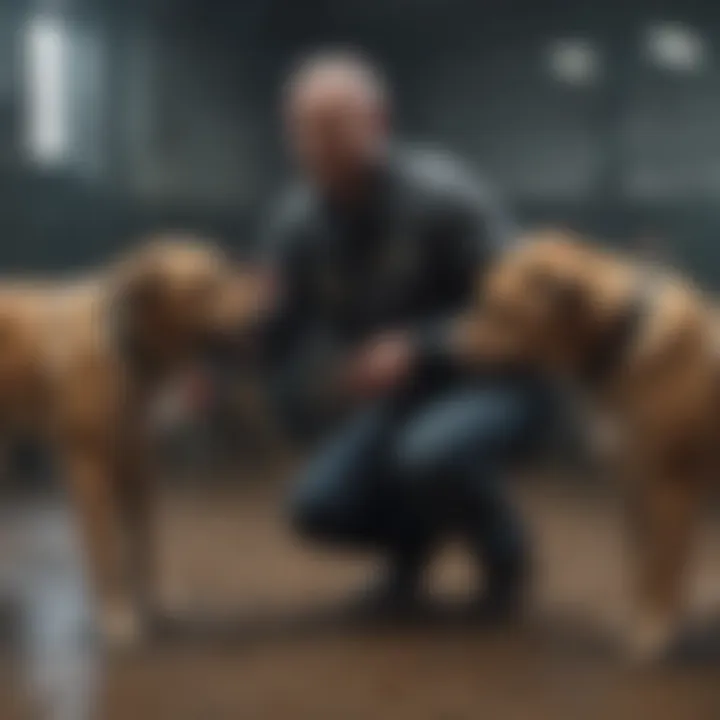Understanding Dog Aggression: Causes and Solutions


Intro
Aggression in dogs is not merely an expression of hostility; rather, it is a complex behavior influenced by various factors. Understanding the roots of this aggression can significantly improve how dog owners and professionals interact with canine companions. This article investigates critical components that contribute to aggressive tendencies. By examining genetics, health, environment, and circumstances that provoke aggression, we can develop more effective strategies to manage such behavior. This discourse intends to shed light on the intricate dynamics of dog aggression, offering insights into how these elements interplay.
Methodology
Overview of Research Methods Used
Research on canine aggression employs a variety of methods. This includes observational studies, surveys, and case studies. Observational studies allow for the direct examination of behavior in natural settings, while surveys can capture data from a broader population of dog owners. Case studies provide in-depth insights into individual instances of aggression, aiding in the identification of patterns or triggers.
Data Collection Techniques
The data collection techniques are diverse and tailored to the goal of the research. These may encompass:
- Surveys: Distributed to dog owners, these solicit details on their dogs' behaviors in various situations.
- Behavioral assessments: Professional evaluations conducted in controlled environments assess responses to stimuli.
- Veterinary records: Analyzing health histories can highlight correlations between aggression and medical issues.
- Interviews: Engaging with trainers and owners more equates insights based on personal experiences.
These methods can unveil the multifaceted nature of aggression and help formulate comprehensive strategies to mitigate such behaviors.
Future Directions
Upcoming Trends in Research
Future research trends focus on deeper genetic studies to identify specific genes linked to aggressive behaviors. Additionally, the impact of early socialization versus late exposure to various stimuli will receive more attention. Understanding these variables could lead to effective prevention strategies.
Areas Requiring Further Investigation
There exists a need for further exploration into the influence of environmental factors on aggression. Specific areas include:
- The role of training methods in altering aggressive behaviors
- Long-term effects of breed-specific legislation on dog behavior
- The psychological impact of owner's behavior on dog aggression
Collectively, attention to these areas will enhance our understanding of aggression in dogs and guide effective intervention strategies.
"Understanding the reasons behind aggression is crucial in developing effective management strategies. Ignorance does not lead to improvement."
Closure
In summary, aggression in dogs is a multifaceted issue that demands comprehensive investigation. By analyzing genetics, health, environment, and triggering situations, we can develop a well-rounded approach for understanding and managing aggressive behaviors. This informed perspective is essential for dog owners, trainers, and veterinary professionals aiming to cultivate better human-canine relationships.
Foreword to Canine Aggression
Understanding canine aggression is essential for both dog owners and professionals working with animals. This topic holds substantial relevance as it touches upon various aspects of dog behavior, including genetic influences, health-related issues, and environmental factors. By dissecting aggression in dogs, we can unveil the complexity of their behavior and the root causes that lead to such tendencies.
Aggression in dogs is not a singular phenomenon but rather a multitude of behaviors that can be observed in different contexts. This article seeks to provide clarity on those different forms of aggression, the triggers associated with them, and their implications. It is important to highlight that aggression is not inherently a reflection of a dog's character, but often a response to external stimuli or circumstances. Thus, acknowledging the multi-dimensional nature of canine aggression can lead to more effective strategies in managing and resolving these behaviors.
One key benefit of studying aggression in dogs is the potential for better communication between the dog and its owner. When owners recognize the signs of distress or aggression, they can take proactive measures. For instance, understanding the common indicators of aggression can allow owners to intervene before situations escalate.
Moreover, effectively addressing aggression can significantly improve the quality of life for both the dog and its owner. It fosters a safer environment and helps to mitigate risks of incidents that could lead to injury for the dog or other individuals. Therefore, knowledge on this subject not only cultivates responsible pet ownership but also contributes to public safety.
Understanding Dog Behavior
Understanding dog behavior is essential for comprehending the underlying causes of aggression. Dogs, as social animals, communicate through various behaviors. By interpreting these signals correctly, owners can take significant steps to prevent aggressive incidents. This section explores the intricate dynamics of canine behavior, emphasizing the need for awareness and knowledge.
Dogs respond to their environment, relationships, and experiences. Understanding their behavior helps in recognizing when a dog may feel threatened or uncomfortable. It can also aid in identifying triggers that lead to aggression. Generally, aggressive behavior can emerge from a variety of influences, including genetic factors and social elements. Recognizing these can facilitate better management of a dog's behavior and overall welfare.
Additionally, understanding dog behavior fosters a stronger bond between the animal and its owner. When owners are aware of their dog's needs and how to address their emotional states, they establish trust. This relationship is fundamental in addressing and modifying aggressive tendencies.
The Nature of Dog Aggression
Dog aggression can manifest in different forms, often rooted in survival instincts. Common manifestations include growling, snarling, snapping, and biting. These actions are responses to a perceived threat, often aimed at protection or self-defense. Understanding the nature of aggression requires insight into its triggers and manifestations.
Several factors contribute to aggressive behavior in dogs:
- Instinctual Behavior: Some breeds have been selectively bred for guarding or herding, which can instill an innate drive to protect.
- Contextual Triggers: Situational factors such as location, presence of other animals, and unfamiliar people can provoke aggressive reactions.
- Past Experiences: Negative interactions or trauma can lead to a defensive attitude and subsequent aggression.
Recognizing the nuanced nature of aggression enables owners to reframe aggressive incidents as opportunities for learning and improvement in handling their dogs.
Common Signs of Aggression


Identifying the signs of aggression in dogs is crucial for prevention and management. Dogs use various signals to convey discomfort or willingness to engage in aggressive behavior. Common indicators include:
- Body Language: Raised hackles, stiff posture, and glaring can indicate a dog is feeling threatened or aggressive.
- Vocalizations: Growls, barks, and whines can serve as warnings. Pay attention to the tone and frequency.
- Facial Expressions: A dog may show teeth or narrow its eyes when on the verge of aggression.
- Lunging or Snapping: This is often a sign of an immediate reaction to a perceived threat.
By observing these signs, owners can take proactive measures to prevent escalation. Understanding these behaviors helps create a safer environment for pets and people alike.
"Recognizing aggression early on can save lives and improve the relationship between a dog and its owner."
Genetic Factors Contributing to Aggression
Understanding genetic factors that contribute to aggression in dogs offers valuable insights for dog owners and professionals. Genetic predispositions can play a significant role in a dog's behavior, informing us why certain breeds may exhibit aggressive tendencies. Exploring these factors highlights the importance of responsible breeding practices and the need for careful consideration when acquiring a dog.
Breed-Specific Traits
Many dog breeds have specific traits that can influence their behavior. Some breeds are simply more inclined towards aggressive behavior due to their history and purpose. For instance, breeds such as the Rottweiler and German Shepherd were historically bred for herding, guarding, and police work, thus developing strong protective instincts. Conversely, breeds like Labradors and Golden Retrievers tend to have more amiable dispositions. This is not to suggest that aggressive behavior is exclusive to certain breeds, but rather that these inherited characteristics can shape tendencies towards aggression.
The environment interacts with these genetic factors, meaning that not all dogs of a specific breed will display aggression. Educating potential dog owners about breed traits can aid them in making informed decisions about which breed may fit best with their lifestyle and intentions.
Inheritance Patterns
Inheritance patterns also play a crucial role in understanding aggression in dogs. Various studies indicate that aggression can be influenced both by dominant and recessive genes. These genes can covertly affect a dog's temperament, making some individuals prone to agression or fearful responses. Through breeding, aggressive tendencies may be exacerbated, particularly if breeders prioritize working traits without considering behavioral implications.
"Understanding genetic contributions to aggression can guide breeding practices and help in developing better dog temperaments."
Moreover, the concept of polygenic inheritance suggests that aggression is likely to be controlled by multiple genes rather than a single genetic marker. This complexity underscores the importance of comprehensive behavioral assessments in breeding programs. Only through a dual focus on genetics and environment can we understand the full scope of aggression in dogs.
Addressing the factors that contribute to inherited aggression not only helps in understanding canine behavior but also informs training and rehabilitation efforts. Responsible ownership, combined with knowledge about genetic influences, can help shape more stable and sociable dogs.
Environmental Influences on Dog Behavior
Understanding how the environment affects dog behavior is essential for dog owners and trainers. Dogs are not only influenced by genetic factors but also by the conditions in which they live. This section discusses three crucial elements: early developmental stages, socialization experiences, and living conditions. Each of these factors can significantly shape a dog's behavior and contribute to aggressive tendencies.
Early Developmental Stages
The early stages of a dog's life are critical for shaping its behavior. Puppies exposed to diverse environments and experiences during their formative weeks are likely to develop more stable temperaments. A lack of exposure can lead to fear and anxiety in adulthood, which may manifest as aggression. It is essential to ensure that puppies are socialized properly with various people, animals, and environments.
Furthermore, early experiences can set the tone for a dog's ability to cope with different situations later in life. Inadequate exposure can result in fear-based aggression, which often develops in response to perceived threats. This early socialization can make the difference between a well-adjusted dog and one that is fearful or aggressive.
Socialization Experiences
Socialization experiences remain crucial throughout a dog's life. Positive interactions with other dogs, people, and various environments promote confidence and adaptability. Conversely, negative experiences can lead to behavioral issues. For instance, a dog that has faced trauma or has had limited exposure to other animals may react aggressively to unfamiliar situations.
Owners should facilitate positive social interactions and continue to expose their dogs to various stimuli. This practice not only helps prevent aggression but also enriches the dog's life. Regularly visiting dog parks, enrolling in training classes, or even arranging playdates can enhance social skills.
Research shows that socialized dogs are less likely to exhibit aggression compared to those that experience isolation, highlighting the importance of these interactions.
Living Conditions and Stress Factors
The living conditions of a dog significantly influence its behavior. Dogs kept in stressful environments may develop behavioral problems, including aggression. Factors such as noise, overcrowding, lack of exercise, and insufficient mental stimulation can all contribute to stress.
A well-structured daily routine that includes time for exercise, play, and mental challenges can help minimize stress. Comfortable living conditions that offer security and predictability are also beneficial. Moreover, observing changes in behavior can provide insights into whether a dog’s living environment is a contributing factor to aggressive tendencies.
In summary, environmental influences play a pivotal role in dog behavior. Understanding how early developmental stages, socialization experiences, and living conditions impact aggression helps in managing and preventing such behaviors effectively. Owners must take an active role in shaping their dogs' experiences, ensuring a balanced environment that promotes positive behavior.
Health-Related Issues
Understanding health-related issues is integral to comprehending aggression in dogs. Physical health can exert a significant influence on a dog's behavior. Many owners are unaware that underlying medical problems can lead to sudden changes in temperament. Identifying and addressing these health concerns can not only improve a dog’s overall well-being but also prevent aggressive behaviors.
Medical Conditions Linked to Aggression
Various medical conditions are known to be associated with aggressive behavior in dogs. Some of these conditions include:
- Neurological Disorders: Conditions affecting the brain can alter a dog’s normal behavior. Issues like seizures might result in unpredictability and stress.
- Hypothyroidism: This hormonal imbalance can manifest in behavioral changes, such as increased irritability or aggression. It’s vital to diagnose this condition early to treat it effectively.
- Cognitive Dysfunction Syndrome (CDS): Similar to Alzheimer’s in humans, CDS affects older dogs. Symptoms may encompass disorientation, anxiety, and altered interactions, which can lead to aggression if a dog feels threatened or confused.
Regular veterinary check-ups are essential for early detection of these conditions. If a dog displays aggression, consulting a veterinarian is crucial. A proper diagnosis could reveal underlying health issues that are contributing factors to the problem.
Pain and Discomfort as Triggers


Pain is a powerful motivator of behavior in dogs. When dogs experience physical discomfort, they may exhibit aggressive tendencies as a means of self-defense. Identifying sources of pain, such as:
- Injuries: Sprains, fractures, or wounds can cause significant pain, prompting a dog to lash out when touched.
- Dental Problems: Issues like periodontal disease can lead to considerable discomfort, making a dog irritable.
- Arthritis: Aging dogs with joint pain may become more aggressive, particularly when they feel threatened or are approached in ways that exacerbate their discomfort.
The key is to recognize signs that your dog may be in pain. Increased aggressive behavior, withdrawal from normal activities, or changes in appetite can indicate that a dog is suffering. Proper pain management and veterinary intervention can alleviate these issues, improving the dog's quality of life and possibly reducing aggressive incidents.
"A thorough assessment of a dog’s health is fundamental to understanding their behavior. If medical issues are resolved, aggressive tendencies may decrease considerably."
By proactively addressing health-related issues, dog owners can not only improve the health of their pets but also mitigate aggression. This is not merely a question of treatment; it includes establishing a sound regimen of regular health evaluations and being observant of any changes in behavior.
Behavioral Triggers for Aggression
Behavioral triggers for aggression are critical to understanding the complexities of aggressive tendencies in dogs. These triggers can lead to various aggressive behaviors that may manifest in different environments and circumstances. Recognizing these triggers allows dog owners and professionals to develop more effective strategies to mitigate aggression. It is essential to examine these contributions, as awareness leads to better management of aggressive behaviors.
Fear-Based Responses
Fear-based responses in dogs can be a significant cause of aggressive behavior. A dog may react aggressively when it feels threatened or unsafe. This reaction often stems from a lack of socialization during critical developmental periods, leading to anxiety in new situations or with unfamiliar people and animals.
Common signs of fear-based aggression include growling, snapping, and lunging. Understanding these responses requires careful observation. When dogs feel cornered or trapped, their instinct is to protect themselves.
Owners can reduce fear-based aggression through several methods:
- Socialization: Introducing dogs to various environments and stimuli early on can lessen fear.
- Desensitization: Gradually exposing dogs to fear-inducing situations in a controlled manner can help them become more comfortable.
- Positive Reinforcement: Rewarding desired behaviors encourages dogs to respond differently in stressful situations.
Addressing fear-related triggers is essential for both the dog's well-being and the safety of others around them.
Territorial Aggression
Territorial aggression occurs when a dog perceives its space or resources as threatened. This behavior often emerges during interactions with other animals or humans entering the dog's perceived territory. Factors such as breed predisposition and past experiences can increase the likelihood of territorial aggression.
Common indications of territorial aggression include barking, growling, and even biting if an intruder comes too close. Ensuring that a dog's behavior is managed appropriately is essential for keeping peace in homes and public spaces.
Steps to manage territorial aggression include:
- Creating Boundaries: Establishing clear boundaries can help the dog understand what constitutes their territory.
- Training Commands: Teaching commands like "leave it" or "go to your mat" can provide owners with tools to manage aggression.
- Controlled Introductions: Introducing new people or pets gradually helps reduce territorial responses.
Awareness of territorial triggers aids in preventing aggressive incidents, ensuring a safe environment for all.
Protective Behaviors
Dogs often display protective behaviors instinctively. This might relate to their role as companions or guardians. While a dog’s protective nature can be beneficial, it sometimes translates into aggression. Dogs may become overly defensive of their family, property, or even their food resources.
Protective behaviors can range from assertive barking to aggressive lunging toward perceived threats. Recognizing the fine line between protective instincts and aggressive outbursts is vital for dog owners.
To manage protective behaviors effectively:
- Training: Consistent training reinforces appropriate responses to perceived threats.
- Social Exposure: Regularly exposing dogs to varied settings and people decreases overprotectiveness.
- Calm Environment: Keeping a calm environment helps lessen a dog’s anxiety and need to protect.
Overall, understanding behavioral triggers for aggression is crucial for fostering healthy relationships between dogs and their human companions. It enables owners to respond actively and effectively, promoting peace and safety in various situations.
Handling and Managing Aggressive Behavior
Understanding how to effectively handle and manage aggressive behavior in dogs is crucial not just for the safety of the individuals around the dog, but also for the well-being of the dog itself. Aggression can lead to severe consequences if not addressed properly. It is essential for dog owners to be proactive and knowledgeable about strategies they can employ. This section explores the immediate safety measures that should be implemented, long-term behavior modification techniques, and the importance of seeking professional help when needed.
Immediate Safety Measures
The first step in addressing aggression is to ensure immediate safety for everyone involved. This includes both humans and other animals. Several measures can be taken to mitigate risk:
- Use a leash or muzzle if necessary. Both tools can prevent a dog from lunging or biting.
- Secure the environment by isolating the aggressive dog. This could mean keeping them in a separate room away from visitors or other pets until they are calmed down.
- Avoid provoking the dog. Steer clear of situations that may exacerbate aggressive tendencies, such as introducing new pets or individuals that may be perceived as threats.
It is important to recognize the signs that a dog is about to become aggressive. Signs could include growling, baring teeth, or a stiff body posture. Addressing these signs early can help to prevent an escalation.
"Safety is not just about preventing aggression; it's also about understanding when and how to intervene."
Long-Term Behavior Modification Techniques
Once immediate safety is ensured, long-term behavior modification becomes the next essential phase. Various techniques can be incorporated:


- Positive Reinforcement: Reward desired behaviors to encourage a more positive response in future situations. For instance, if a dog remains calm in a stressful situation, offering treats can reinforce that behavior.
- Desensitization: Gradually exposing the dog to the stimulus that triggers aggression can help them build tolerance over time. This process should be approached slowly and carefully, always monitoring the dog's stress levels.
- Counter-Conditioning: This technique involves changing a dog's emotional response to a specific trigger. For instance, if a dog reacts aggressively to strangers, rewarding the dog for calm behavior around known people can help condition a different response to new individuals.
Consistency in training and applying these methods is vital for success. Abandoning routines can lead to setbacks in progress.
Utilizing Professional Help
In many cases, engaging with a professional dog trainer or behaviorist is advisable for addressing significant aggression issues effectively. Professionals usually bring a wealth of experience that can benefit both the owner and the dog. Some reasons to seek professional help include:
- Expert Knowledge: Professionals understand behaviors and triggers better, allowing for more accurate diagnosis of the root causes of aggression.
- Tailored Training Programs: Each dog is different, and a professional can create a customized training program based on the dog's specific needs and challenges.
- Support and Guidance: The emotional toll of managing an aggressive dog can be heavy. A professional can provide the necessary support and encouragement throughout the process.
Preventive Strategies for Dog Owners
Preventive strategies for dog owners play a crucial role in curbing aggressive behavior in dogs. By adopting a proactive approach, owners can enhance their dogs’ social skills and reduce the likelihood of future aggression. Early intervention not only aids in shaping a dog's behavior but also fosters a positive relationship between dogs and their owners. The objective is to equip owners with practical methods and insights to cultivate a calmer and more pleasant environment for their pets.
Early Socialization Practices
Early socialization practices are essential for developing well-adjusted dogs. This process involves exposing puppies to various experiences, people, and other animals during their critical developmental period, which typically spans from three to fourteen weeks of age. The goal is to familiarize puppies with different situations so they can respond positively rather than with fear or aggression later in life.
Research has shown that dogs who undergo proper socialization are more confident and adaptable. Concrete strategies to implement socialization include:
- Attending puppy classes: These classes provide structured environments for interaction with other dogs and people.
- Visiting various environments: Taking dogs to diverse settings like parks, shopping centers, and friend’s homes helps them adapt to different stimuli.
- Encouraging positive interactions: Owners should guide and reward their puppies for good behavior in new situations, reinforcing the idea that exploration is safe and enjoyable.
Ongoing Training and Reinforcement
Ongoing training and reinforcement are critical for maintaining desired behaviors in dogs. While initial socialization is vital, it is equally important for owners to engage in continuous training throughout their dog’s life. Consistent training helps reinforce commands and reduces the risk of behavioral regression over time.
Key aspects of ongoing training include:
- Regular training sessions: These should be short and engaging, focusing on basic commands and positive reinforcement techniques. This strategy instills discipline and encourages good behavior.
- Incorporating training into daily activities: Owners can seize everyday moments for training opportunities, turning routine outings into learning experiences.
- Seeking advanced training when needed: If behavioral issues arise or if owners want to enhance their dog’s skills, consulting a qualified trainer can provide tailored guidance.
By integrating preventive strategies such as early socialization and ongoing training into their routines, dog owners can significantly enhance their pets' behavior. This foundation builds trust and communication, ultimately leading to a more harmonious relationship.
The Role of the Owner in Canine Behavior
Understanding the role of the owner in canine behavior is essential for managing aggression effectively. This section delves into how owner attitudes and practices shape a dog's behavior. Often, the relationship between a dog and its owner can influence an animal’s development and reactions to various situations. An owner who displays fear or anxiety may inadvertently pass these emotions onto their canine companion, leading to increased aggression or fear-based responses. Hence, recognizing the owner's influence is vital for fostering a balanced disposition in dogs.
Owner Attitudes and Their Impact
The attitudes that owners hold towards their dogs play a significant role in the behavioral outcomes observed in their pets. Dogs are remarkably perceptive, ingesting cues from their owners' emotions and behaviors. For instance, an owner that often corrects their dog with harsh tones might instill fear, leading to defensive or aggressive behaviors. Likewise, overindulgence and a lack of boundaries can create confusion and stress in a dog. Dogs thrive in environments where they understand their place in the household hierarchy. Thus, it is essential for owners to maintain a balance between affection and discipline to promote a well-adjusted dog.
Adopting a positive attitude can yield tangible benefits:
- Reduced anxiety in the dog.
- Enhanced learning capabilities.
- Strengthened owner-dog bonds.
This proactive attitude creates an atmosphere where dogs feel safe and understood, fostering improvements in behavior.
The Importance of Consistency
Consistency is paramount in dog training and behavior management. Dogs rely on predictable environments to learn and adapt. When commands or rules are not consistently enforced, it can lead to confusion and frustration. For example, if an owner allows certain behaviors one day and reprimands them the next, the dog is left bewildered by what is acceptable.
Establishing clear and consistent rules helps to develop trust between the owner and the dog. It aids the dog in understanding expectations, which in turn supports effective training. Simple, repetitive commands that are met with consistent responses can lead to quicker learning and stable behavior. Furthermore, maintaining the same behavioral standards across all family members reinforces the message, as conflicting signals can exacerbate aggression or anxiety in dogs.
To encapsulate, a conscientious owner approach encompasses:
- Setting clear boundaries.
- Ensuring uniform commands are used by all family members.
- Maintaining a steady routine that contributes to a secure environment.
Owner involvement is a crucial aspect of addressing aggression in dogs. By fostering the right attitudes and maintaining consistency, dog owners can significantly influence their pets’ overall behavior and emotional well-being.
The End: Addressing Aggression Effectively
In the comprehensive analysis of canine aggression, reaching a conclusion about how to address this behavior effectively is essential. Aggression in dogs is a complex issue that demands a multifaceted approach. It is not just about the action itself but understanding the why behind it. One of the critical elements is recognizing that aggression can arise from a combination of genetic, environmental, and situational factors.
To address aggression appropriately, it is crucial to first identify the underlying causes. Owners must consider specific aspects such as whether the aggression stems from fear, territorial instincts, or health issues. Therefore, careful observation and a good knowledge of a dog's behavior are essential. Observing body language and understanding triggers can provide insight into what may provoke aggressive responses.
"Understanding the causes of aggression is the first step to managing it effectively."
Training plays an indispensable role in mitigating aggressive behaviors. Consistent and positive reinforcement training helps dogs learn alternative behaviors. It is beneficial for owners to seek professional help. Trainers can implement specialized programs tailored to the dog’s individual needs, promoting better behavior without relying on destructive methods.
Moreover, it is significant to establish a safe environment for the dog. Engaging in regular exercise and mental stimulation can alleviate excess energy that may lead to aggressive tendencies. Additionally, socialization from a young age helps create a well-adjusted dog with fewer behavioral issues.
Ultimately, addressing aggression effectively involves a balanced view. It demands patience, understanding, and commitment from dog owners. By fostering a deeper awareness of aggression’s causes and solutions, we move closer to rectifying unwanted behaviors while nurturing a stronger bond with our canine companions.
In summary, the conclusion regarding aggression in dogs is not to view it solely as a behavioral flaw but as a manifestation of various factors requiring thoughtful intervention. By acting proactively and engaging in targeted strategies, owners can mitigate aggression, paving the way for a harmonious relationship with their pets.







